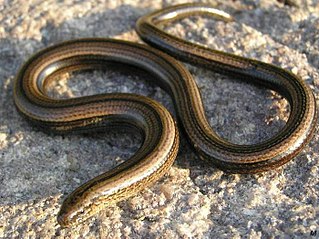
Anguidae refers to a large and diverse family of lizards native to the Northern Hemisphere. Common characteristics of this group include a reduced supratemporal arch, striations on the medial faces of tooth crowns, osteoderms, and a lateral fold in the skin of most taxa. The group is divided into two living subfamilies, the legless Anguinae, which contains slow worms and glass lizards, among others, found across the Northern Hemisphere, and Gerrhonotinae, which contains the alligator lizards, native to North and Central America. The family Diploglossidae was also formerly included. The family contains about 87 species in 8 genera.

Gerrhonotus is a genus of anguid lizards that are commonly referred to as alligator lizards, due to a vague resemblance to an alligator. Most species are restricted to Mexico, but a few range into Guatemala or Texas, and G. rhombifer is from Costa Rica and Panama. Along with glass lizards (Ophisaurus) and many other lizards, alligator lizards have the ability to regrow their tail.

The southern alligator lizard is a common species of lizard in the family Anguidae. The species is native to the Pacific coast of North America. It ranges from Baja California to the state of Washington and lives in a variety of habitats including grasslands, chaparral, forests, and even urban areas. In dry climates, it is likely to be found in moist areas or near streams. There are five recognized subspecies.

The northern alligator lizard is a species of medium-sized lizard in the family Anguidae. The species is endemic to the North American west coast.

Arend Friedrich August Wiegmann was a German zoologist and herpetologist born in Braunschweig.
Edward Harrison Taylor was an American herpetologist from Missouri.

The Texas alligator lizard is a species of lizard in the subfamily Gerrhonotinae of the family Anguidae. The species is endemic to the central region of the American state of Texas, and south into adjacent northern Mexico.

Abronia deppii, Deppe's arboreal alligator lizard, is an endangered species of arboreal alligator lizard in the family Anguidae. The species was described in 1828 by Arend Friedrich August Wiegmann, and it is endemic to Mexico.

Abronia matudai, Matuda's arboreal alligator lizard, is a species of endangered arboreal alligator lizard in the family Anguidae. The species, which was originally described in 1946 by Norman Hartweg and Joseph Tihen, is endemic to Central America.

Abronia ochoterenai, Ochoterena's arboreal alligator lizard or Northern Chiapas arboreal alligator lizard, is a species of arboreal alligator lizard in the family Anguidae. The species, which is native to extreme southern Mexico, was described in 1939 by Rafael Martín del Campo.

The isthmian alligator lizard is a species of lizard of the Anguidae family. G. rhombifer is found in both Costa Rica and Panama. Unlike many lizards near its habitat, individuals have lateral folds. They give birth to live young. Gerrhonotus rhombifer had not been seen for fifty years, prior to being rediscovered in 2000 near Golfito, and is one of the rarest species of lizard in Costa Rica.

The Madrean alligator lizard, also known commonly as King's alligator lizard and el lagarto de montaña in Mexican Spanish, is a species of lizard in the family Anguidae. The species is native to the southwestern United States and adjacent northwestern Mexico.

Gerrhonotus parvus is a species of lizard in the subfamily Gerrhonotinae. It is endemic to the state of Nuevo León, Mexico. The name parvus is from the Latin word for small because it is the species of smallest adult size recognized in the genus Gerrhonotus. It lives in dry forests transitioning to scrub in the eastern Sierra Madre Oriental at elevations of 900–1,650 m (2,950–5,410 ft) above sea level. They are usually found among dead leaves of yuccas in open wood areas. It seems to prefer dry limestone canyons. It is a relatively small species, with the maximum reported snout–vent length at 76 mm (3.0 in). It is oviparous and has a litter size of 4–6 eggs. Its head is glossy and smooth, grayish brown in color with scattered dark spots. The lips are peppered with pigment and the chin and throat are white in color.
Gerrhonotus farri, also known commonly as Farr's alligator lizard and the Tamaulipan alligator lizard, is a species of lizard in the family Anguidae. The species is native to northeastern Mexico.
Gerrhonotus lazcanoi is a species of lizard of the Anguidae family. It is found in Mexico.

Gerrhonotus liocephalus, the Texas alligator lizard or Wiegmann's alligator lizard, is a species of lizard of the Anguidae family. It is found in Texas, Mexico and Guatemala.

Gerrhonotus lugoi, Lugo's alligator lizard, is a species of lizard of the Anguidae family. It is found in Mexico.

Gerrhonotus ophiurusis a species of lizard of the Anguidae family. It is found in Mexico.
Barisia ciliaris, also known commonly as the Sierra alligator lizard, the imbricate alligator lizard, and el escorpión de montaña in Mexican Spanish, is a species of medium-sized lizard in the family Anguidae. The species is endemic to Mexico.

Barisia imbricata, also known commonly as the imbricate alligator lizard, the transvolcanic alligator lizard, and el escorpión de transvolcánico in Mexican Spanish, is a species of medium-sized lizard in the family Anguidae. The species is endemic to Mexico.














